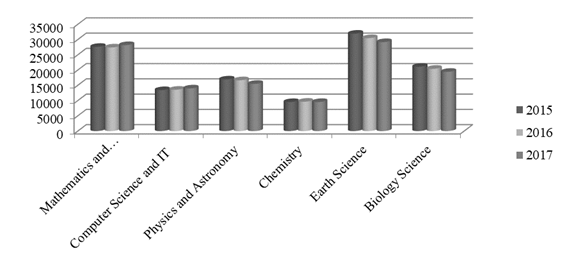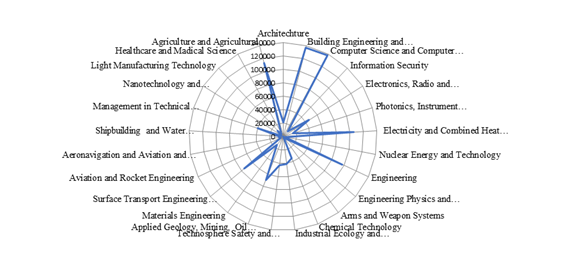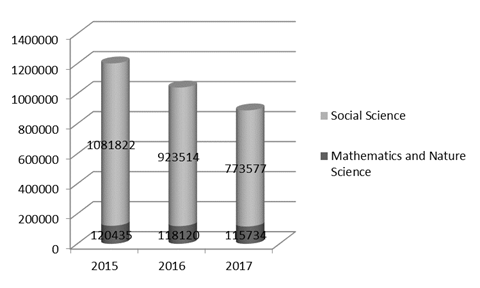Abstract
For Russia, recent strengthening of world economic and political conditions places greater demands regarding procedures for science-based priorities of scientific innovation and the choice of approaches to human capital development. Accelerated technological upgrading of new economies involves expanding public policies on developing professional competences meeting the requirements of innovative development. When it comes to the innovative development of our country, its effectiveness will depend on proficiency and objectives of future specialists. The most significant problem of implementing public policy in science and advanced technologies is appropriate staffing of innovative activity. The analysis of people participating in science and innovation reveals their ageing in Academies of sciences and universities and research organizations through the last 10-15 years. The ageing was accompanied by decrease in the number of staff occupied with research and development, which has decreased three times over the last 10 years. Thus, there is a problem of insufficient staffing of research organizations. The paper shows that educative features of human potential do not correspond with the goals of renovated economy in modern Russia. The structure of specialties and competences by current system of higher education has fallen short of both challenges of innovative development of domestic economy and structural shifts in the world economy.
Keywords: Higher education systemhuman capitalinnovationsinnovative developmentproject office
Introduction
According to the law, the subjects of innovative development are innovative technological centers, research laboratories of major universities, technology incubators, business centers, etc. These include all organizations encouraging innovative activity in various spheres of science and economy.
Under the Federal Law of the Russian Federation of July 21, 2011 No 254 innovative infrastructure consists of organizations encouraging innovative activity: scientific and technological, educational, industrial organizations and their partnerships, technological incubators, technopoles, technoparks, educational and business centers, innovative and venture funds, other specialized organizations, as well as innovative and technological centers and the offices of commercializing R&D, with educational centers playing a key role in this research.
Human capital status in a country is objectively reflected by the Human Development Index (HDI). In 2005, Russia remained the lowest 49th place (0.804) and was among countries with the 'very high' HDI. However, given enormous scientific and technical potential, natural wealth and human resources in the country, its HDI may be defined as ‘low’ (Malykh, Yarnykh, Oveshnikova, & Sibirskaya, 2017). In this regard, the authors have decided to depart from the traditional list of performance indicators and research into the system of training for consistency with the challenges of national innovative development.
Problem Statement
The disequilibrium in Russian human potential structure implies a thorough analysis of the current status and trends of national socioeconomic development within the current stage of global scientific and technological development.
Research Questions
While conducting the research, the authors hypothesized the need for a unified approach to assessing the development of organizations promoting innovation, new training priorities, Russian innovative clusters, centres for innovative, technological and social modernization of regions.
Purpose of the Study
The main purpose of the study is the research of new trends in higher education and a factor of building and developing human potential in the context of new shifts in science and technology, and the integration of new approaches in this sphere.
Research Methods
The methodological basis for the study are general scientific methods of cognition: dialectic, historic and logical methods, as well as methods of structural and functional analysis, empirical generalization and comparison, the tabular and graphic presentation of statistical data. The foundation of working out the directions of higher education development involved systemic and situational analysis.
Findings
Many researchers have previously showed that the trends of innovation in developed countries claiming active participation in developing technologies for the new (sixth) technological paradigm highlighted engineering and technical competences required by real sector, as well as research competences involved in the preparation of expanded reproduction (Eldyaeva, Yarnykh, Lebedinskaya, Kuzin, & Kovanova, 2018). It is therefore entirely appropriate that most technologically advanced countries now experience outstripping development of scientific and engineering and technical education, as well as strengthened cooperation between business, science and education in order to work out and intense model of training to meet the needs of innovative economy (Sharkova & Merzlova, 2013; Pelinescu, 2015; Cherkesova, Belikova, Popova, Sukhova, & Demidova, 2015).
However, with an agreement on the need to develop Engineering and Technology, domestic training system is somewhat different. Undoubtedly, the decrease of 500 thousand in the total number of students (from 3531 thousand in 2015 to 3033 thousand in 2017) is influenced by population number in age groups, though, the structure of training (the range) is a variable. Thus, the aggregative group of study fields ‘Mathematics and Natural Science’ experiences the decrease of 14.11 per cent of students. Among the leaders of negative development are ‘Physics and Astronomy’ (-8.52 per cent), ‘Earth Science’ (-8.62 per cent), ‘Biological Science’ (-7.9 per cent).

The aggregative group of study fields ‘Engineering, Technology and Technical Science’ experiences the decrease of students in fourteen fields. The trend does not change in spite of the increase of state-financed places in this field comparing to the national average (78-90 per cent versus 40.23 per cent in 2017 (see fig.

The analysis showed that the adoption and active implementation of NTI programs did not trigger any fundamental change during this period. The range of study fields still does not meet the needs of innovative development. This includes multiple backlog of the number of the trained in universities in Science and Engineering study fields from those in Economics and Management despite only a small proportion of state-funded places (12.98 per cent in 2015 and 13.53 in 2017) (see fig.

Undoubtedly, new courses such as ‘Medical Biophysics’, ‘Medical Cybernetics’, etc. are introduced, but it seems to be insufficient. The number of students of some majors is unacceptably small throughout the country (16.03.02 ‘Hightech plasma and power supply activities’ – 123 pers., 12.03.03 ‘Photonics and optoelectronics’ – 603 pers, 28.03.03 ‘Nanomaterials – 199 pers., 14.05.03 ‘Isotope separation technology and nuclear fuel – 143 pers., 26.05.02 ‘Power generating system and ship automation system design, fabrication and installation’ – 31 pers., 26.05.01 ‘Ship and ocean engineering design and building’ – 146 pers., 27.05.02 ‘Metrological support of weapons and military equipment’ – 48 pers.), etc.
The lack of students in study fields sought after by science determines insufficient participation of universities in the implementation of pilot innovative programs.
The list of higher education organizations acknowledged as university centers for innovative, technological and social regional development was adopted on December 19, 2017. The list embraced 51 university, with their number totalling 100 by 2025. 39.5 bln rubles from federal budget and 5 bln rubles from extrabudgetary funding sources will be allocated to implement the project. A further 30 bln rubles of budget allocation are allocated for state support of basic universities in 2018-2020 (33 basic universities in 32 Russian subjects have got about 3 bln rubles).
Despite the fact that only 4 out of 26Russian innovative clusters do not involve universities, only 12 of them have the status of ‘a university center for innovative, technological and social regional development’ (Russian cluster observatory of NRU HSE, 2015; The Enactment by the Ministry of Education and Science of the Russian Federation No Р-1002, 2017) The rest of them with the status are not involved in clusters despite they are situated in the regions where there is a successful cluster and a training program for its work. For instance, the Altai State University trains bachelors in 04.03.01 ‘Chemistry’, 19.03.01 ‘Biotechnology’, 33.05.01 ‘Pharmacy’, 04.05.01 ‘Fundamental and applied chemistry’, masters in 04.04.01 ‘Chemistry’ by majors ‘The development of biopharmaceuticals based on recombinant technology’, ‘Nanoengineering of functional and biomimetic materials’, there post-graduate courses in Chemistry and Biology
Currently, only four out of ten federal universities are involved in the creation of pilot clusters. The proportion of participants among national research universities is higher (58.6 per cent, 17 out of 29), but still inadequately small.
The work of pilot innovative clusters includes three options for university cooperation:
the establishment of educational programmes in the training, retraining and advanced training fields being of priority for cluster participants;
conducting applied research in cooperation with business;
cooperative use of university innovation infrastructure.
Evidence shows that a university can work actively either within one cluster (Saint Petersburg State Chemical Pharmaceutical Academy) or in a several ones (Saint Petersburg State Technical University (all pilot clusters of Saint Petersburg)), Lomonosov Moscow State University (Dubna, Pushchino, Moscow), (National Research Tomsk Polytechnic University), be either a participant (regional branches of MEPhI, Ogarev Mordova State University), or an initiator of creating a cluster (Moscow Institute of Physics and Technology, Lomonosov Moscow State University (a biotechnological cluster), Moscow State Technical University named after N. E. Bauman (a composite cluster).
Great advantages of university participation in a cluster are:
fellowship, practical training and placement opportunities for graduates within the businesses involved in a cluster (enhanced university profile in educational market)
training (advanced training) of the staff of cluster participants
conducting R&D in the interests of participating businesses as well as cooperative projects in R&D (including the creation and commercialization of intellectual property objects
staff mobility, including the involvement of practicioners from participating businesses into educational projects and advanced training of university staff at participating businesses
cooperative creation and/or use of innovative infrastructure (business incubators, technoparks, innovation and technology centers, engineering centers, certification centers, technology transfer centers, collective use centers, etc.).
The analysis showed that What matters is not so much the formal university presence in clusters but the quality of their cooperation with other participants. Currently, there is significant room for innovative cluster development based on cooperation with universities. Well-structured and target-oriented work with clusters, regional innovative infrastructure, regional business associations can give an additional impetus to the interaction ‘university – business’, the exchange of best practices of university participation in clusters by type of cooperation: the development of educational programs, cooperative use of innovative infrastructure, cooperation in research and development.
Conclusion
The analysis showed that since the NTI was adopted and being implemented in our country, necessary fields of study have not been developed.
The main problem concerning the management of human capital development lies in the absence of a single unit authorized and able to coordinate the use of all kinds of education. It should be an umbrella coordinating body as the incoherence of separate infrastructure objects of different subordinate governance makes both the systematization and the use of objects much more difficult.
The second task of a coordinating body should be the development of single and common mechanisms of access to grant financing of education.
Finally, the third task (the last, but not the least) for a coordinating body should be working out the road map of science infrastructure development in Russia based on state priorities, current and planned budget means, targets of science and research over the next 10-15 years. To redress current imbalance in the development of certain objects of infrastructure it is desirable to provide immediate feedback while developing a coordinating body.
References
- Cherkesova, E. Y., Belikova, S. S., Popova, E. M., Sukhova, A. A., & Demidova, N. E. (2015). Mechanism of Development of Human Capital Within Human Resources Management of Modern Organization. Mediterranean Journal of Social Sciences, Vol. 5. DOI:
- Eldyaeva, N. A., Yarnykh, E. A., Lebedinskaya, O. G., Kuzin, S. I., & Kovanova, E. S. (2018). Characteristics of the state of Russia’s labor potential as a component of economy’s innovational development. Advances in Intelligent Systems and Computing, 622, 744-750. DOI:
- Malykh, N., Yarnykh, E., Oveshnikova, L., & Sibirskaya, E. (2017). Basic Elements of Statistical and Information Technology Application of Foresight Tools for Attracting Investments into the National Economy. In E. G. Popkova (Ed.) Overcoming Uncertainty of Institutional Environment as a Tool of Global Crisis Management (pp. 359-380). Cham, Switzerland: Springer Nature. DOI:
- Pelinescu, E. (2015). The Impact of Human Capital on Economic Growth. Procedia Economics and Finance, 22. DOI:
- Russian cluster observatory of NRU HSE (2015). Received October 16, 2018, from https://cluster.hse.ru/innovative_clusters.
- Sharkova, A., & Merzlova, M. (2013). Factors of the formation and development of human capital in an innovation-based economy. Law and modern states, 4, 9-13. Received April 10, 2018, from https://cyberleninka.ru/article/n/factors-of-the-formation-and-development-of-human-capital-in-an-innovation-based-economy.
- The Enactment by the Ministry of Education and Science of the Russian Federation No Р-1002 (2017). ‘On the Approval of the List of educational organizations of higher education acknowledged as the centers for innovative, social and regional development. Received February 17, 2017, from http://centervuz.ru/documents/list.pdf.
Copyright information

This work is licensed under a Creative Commons Attribution-NonCommercial-NoDerivatives 4.0 International License.
About this article
Publication Date
02 April 2019
Article Doi
eBook ISBN
978-1-80296-058-7
Publisher
Future Academy
Volume
59
Print ISBN (optional)
-
Edition Number
1st Edition
Pages
1-1083
Subjects
Business, innovation, science, technology, society, organizational theory,organizational behaviour
Cite this article as:
Timofeev, A., Lebedinskaya, O., Yarnykh, E., & Kurnikova, M. (2019). The Influence Of Human Capital Development On National Innovative Potential. In V. A. Trifonov (Ed.), Contemporary Issues of Economic Development of Russia: Challenges and Opportunities, vol 59. European Proceedings of Social and Behavioural Sciences (pp. 218-224). Future Academy. https://doi.org/10.15405/epsbs.2019.04.25

